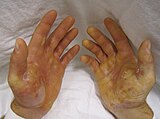| Type
|
Locus & Gene
|
OMIM
|
|
Epidermolysis bullosa simplex with migratory circinate erythema
|
12q13 (KRT5)
|
609352
|
Epidermolysis bullosa simplex with mottled pigmentation.
- Associated with a recurrent mutation in KRT14.
|
12q13 (KRT5)
|
131960
|
|
Epidermolysis bullosa simplex, autosomal recessive
|
17q12-q21 (KRT14)
|
601001
|
Generalized epidermolysis bullosa simplex
- Also known as "Koebner variant of generalized epidermolysis bullosa simplex", presents at birth to early infancy with a predilection for the hands, feet, and extremities, and palmar-plantar hyperkeratosis and erosions may be present.
|
17q12-q21 (KRT5), 12q13 (KRT14)
|
131900
|
Localized epidermolysis bullosa simplex
- Also known as "Weber–Cockayne syndrome" and "Weber–Cockayne variant of generalized epidermolysis bullosa simplex", is characterized by onset in childhood or later in life, and is the most common variant of epidermolysis bullosa simplex.
|
17q12-q21 (KRT5), 17q11-qter, 12q13 (KRT14)
|
131800
|
Epidermolysis bullosa herpetiformis
- Also known as "Dowling-Meara epidermolysis bullosa simplex", presents at birth with a generalized distribution, often with oral mucosa involvement and variable lesions in infancy.
|
17q12-q21 (KRT5), 12q13 (KRT14)
|
131760
|
Epidermolysis bullosa simplex with muscular dystrophy
- A rare clinical entity, and is the only epidermolytic epidermolysis bullosa described that is not caused by a keratin mutation, presenting as a generalized intraepidermal blistering similar to the Koebner variant of generalized epidermolysis bullosa simplex, but also associated with adult onset muscular dystrophy.
|
8q24 (PLEC1)
|
226670
|
|
Epidermolysis bullosa simplex with pyloric atresia
|
8q24 (PLEC1)
|
612138
|
Epidermolysis bullosa simplex of Ogna
- Has onset in infancy, presenting with seasonal blistering on acral areas during summer months.
|
8q24 (PLEC1)
|
131950
|

